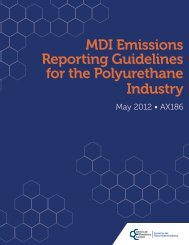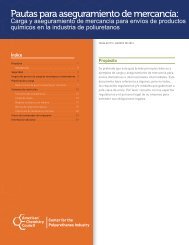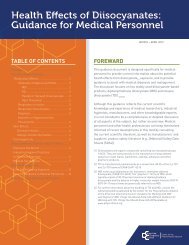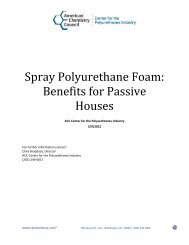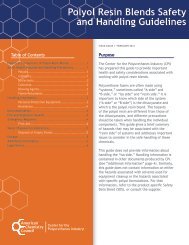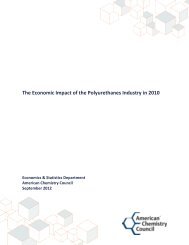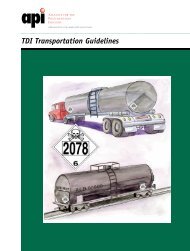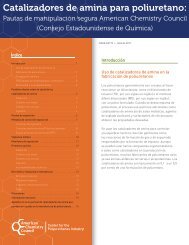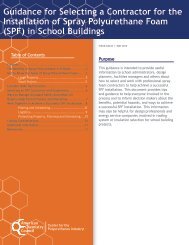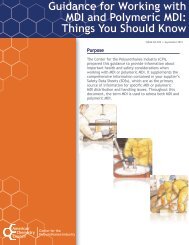MDI Emissions Reporting Guidelines for the ... - Polyurethanes
MDI Emissions Reporting Guidelines for the ... - Polyurethanes
MDI Emissions Reporting Guidelines for the ... - Polyurethanes
Create successful ePaper yourself
Turn your PDF publications into a flip-book with our unique Google optimized e-Paper software.
<strong>MDI</strong> <strong>Emissions</strong> <strong>Reporting</strong> <strong>Guidelines</strong> <strong>for</strong> <strong>the</strong> <strong>Polyurethanes</strong> Industry<br />
liquid and <strong>the</strong> temperature of <strong>the</strong> vapor space may be different from <strong>the</strong><br />
ambient temperature. Empirical <strong>for</strong>mulas are provided to determine <strong>the</strong><br />
required temperatures if <strong>the</strong> ambient temperature and <strong>the</strong> daily range are<br />
given.<br />
Determination of <strong>the</strong> breathing losses through <strong>the</strong> new EPA method is quite<br />
tedious. A software program to evaluate storage tank losses (working losses<br />
and breathing losses) was developed by <strong>the</strong> EPA. The software (TANKS) is<br />
available <strong>for</strong> downloading from <strong>the</strong> EPA at<br />
http://www.epa.gov/ttnchie1/software/tanks/.<br />
3. Comparison of results<br />
The simplified method used <strong>for</strong> <strong>the</strong> <strong>MDI</strong> <strong>Emissions</strong> Estimator is an adaptation<br />
of <strong>the</strong> new EPA method. In developing <strong>the</strong> simplified method, <strong>the</strong> following<br />
assumptions are made:<br />
The pressure term in <strong>the</strong> vapor space expansion factor is ignored. It<br />
can be shown that <strong>for</strong> liquids having a low vapor pressure <strong>the</strong> pressure<br />
term is negligible relative to <strong>the</strong> temperature term and can thus be<br />
ignored.<br />
The vented vapor saturation factor is 1.0. It can be shown that <strong>for</strong><br />
liquids having a low vapor pressure <strong>the</strong> vented vapor saturation factor<br />
approaches 1.0.<br />
The average liquid surface temperature and <strong>the</strong> vapor temperature<br />
are <strong>the</strong> same as <strong>the</strong> ambient temperature.<br />
Under <strong>the</strong>se circumstances, <strong>the</strong> simplified method will yield identical results<br />
to <strong>the</strong> new EPA method.<br />
Table C-1 provides a side-by-side comparison of <strong>the</strong> working losses and<br />
breathing losses <strong>for</strong> <strong>the</strong> three methods discussed above.<br />
COMPARATIVE EXAMPLE<br />
The following illustrative example demonstrates <strong>the</strong> equivalency between <strong>the</strong><br />
simplified method and <strong>the</strong> new EPA method when simplifying assumptions are<br />
made:<br />
A fixed roof vertical tank contains <strong>MDI</strong>. The tank has a volume of 11,750<br />
gallons (10’ D x 20” H) and is half full. The tank is located in New York. From<br />
meteorological data, <strong>the</strong> daily average ambient temperature is 54.55 o<br />
F<br />
C-4



